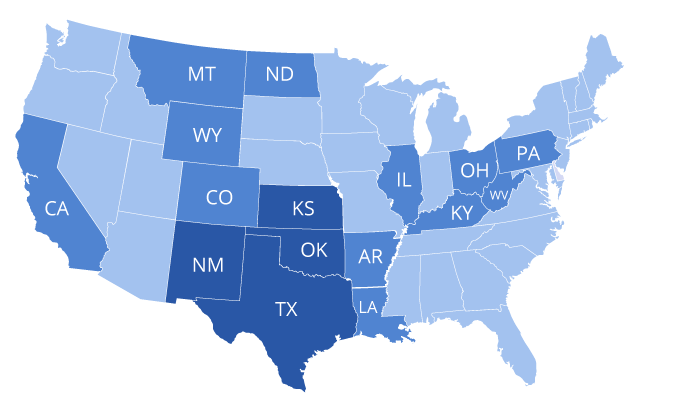Rooks County Mineral Rights
We buy oil and gas royalties and mineral rights in Kansas and throughout the United States.
Sell Your Mineral Rights (Request an Offer):
Northwest Kansas
Rooks County, Kansas
A brief overview of oil and gas activity
Rooks County is located in Northwest Kansas and ranks as the sixth most prolific oil-producing county in Kansas.
Rooks County’s oil wells are conventional vertical wells (imagine a straw in a jelly doughnut), and many were plugged long ago. Most wells in Kansas are stripper wells, meaning they produce less than 15 barrels of oil or less than 90 MCF of gas per day. By contrast, many horizontal wells in Texas and Oklahoma produce north of 500 barrels per day.
Striper wells have their place in our energy mix. They make up 7.4% of US oil production. Stripper wells also disproportionally contribute to methane emissions which hurt the environment. The current administration is attempting to curtail methane emissions, putting financial stress on small operators and may make many stripper wells uneconomical. Once a well is uneconomical, it is plugged, and mineral owners no longer receive royalty payments.
Kansas oil wells account for 1.1% of US oil production and 0.5% of US gas production (source: ShaleXP).

Step-by-Step Process
How Do I Locate My Kansas Mineral Rights?
Kansas recently updated its interactive map. It’s much more user-friendly, making it a breeze for mineral and royalty owners to find the information they need!
Knowing your legal description makes it easy to locate your oil and gas wells. Not sure where to find the legal description? It’s on your property deed and your oil and gas lease.
Kansas uses the Public Land Survey System (PLSS), so your legal description will consist of a section, range, and township.
For example, in Rooks County, Kansas, you might see something like:
Section 27, Township 18 South, Range 19 West
Need more help? Contact us, and we will be happy to look it up for you!
Use KGS’s GIS map to:
- Locate wells
- View well info (depth, dates, fields, operator, etc.)
- View well status (active, plugged, water flood, dry holes, etc.)
- View production history
- And more

A Brief Overview
Rooks County Oil Wells
The Lansing-Kansas City and Arbuckle groups are part of the Central Kansas Uplift and are the main oil-producing geological formations in Rooks County.
This map shows a typical area of Rooks County with a mix of dry holes, producing wells, and old plugged wells. As you can see, there are more plugged wells than producing wells. Because oil is a finite resource, all of these wells will eventually run dry.
Many of these wells in this area of the map only produce a fraction of the oil they once produced and will probably be plugged soon.
There are very few opportunities for new development in Kansas because most energy companies prefer to drill long, fracked horizontal wells in the popular shale basins (less risk and more potential for profit).
Compare Counties
Modern Oil & Gas Drilling
Russell County ranks #6 in oil production in Kansas and #222 nationally. The top operators include Vess Oil, Gore Oil, Berexco, Citation, American Warrior, and others.
The typical well in Kansas produces less than 15 barrels of oil per day. By contrast, many counties in Texas have wells that produce more than 500 barrels of oil per day.
It’s really easy to see why Kansas sees very little new oil and gas development these days. Today’s oil and gas exploration companies are more interested in drilling in the shale basins where opportunites are better and risk is lower.

Top Valuation Factors
How We Value Mineral Rights
There are many factors that play into the value of mineral rights. These include location, producing vs. non-producing properties, current oil and gas prices, well production figures, lease terms, and even the operator of the well or wells. We also look at the risks of buying and owning minerals that you are interested in selling.
Location
Minerals in the hottest shale plays are more valuable than those in older fields with conventional wells.
Producing vs. Non-Producing
Producing minerals are often worth more than non-producing minerals because they are generating revenue.
Oil & Gas Prices
When oil and gas prices drop, revenue drops, and sometimes operators are unable to continue operating the well.
Production
Highly productive wells (and off-set wells) can increase the value of your minerals.
Lease Terms
Favorable lease terms (such as a 25% royalty reservation) positively impact the value of the leased minerals.
Operator
A small number of operators are unethical, and their reputation automatically devalues your minerals.
Nationally Focused
Where We Buy Mineral Rights
We buy both producing and non-producing minerals in all oil and gas states. However, we are especially interested in Texas and Kansas mineral rights.
|
We even buy minerals in more obscure states, which produce very little oil and gas compared to other states.

Why Sell?
Why People Sell Their Mineral Rights
I am putting my affairs in order. I don’t want to burden my kids with the hassle of transferring ownership and managing small mineral rights. When my sister passed away, my niece and nephew had to hire an attorney to help them with the minerals. I don’t want my kids to go through that.
I inherited my mineral rights so they were sentimental, but I don’t really want to bother with managing them and filing extra tax returns. I decided to sell and use the money as a down payment on my house.
I had no idea how fast the oil production would decline. My checks are only 20% of what they were a few years ago. I should have sold my mineral rights when the wells were brand new and still generating huge royalties.
My oil wells have been producing for decades and the reserves are almost depleted. Once the wells are plugged, the value will be significantly lower. I’d rather cash out now.
I inherited mineral rights, but don’t want to be involved with fracking and fossil fuels. I would prefer to support renewable energy and do my part to reverse climate change.
